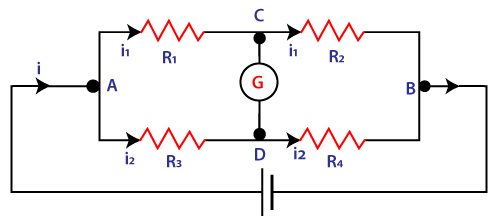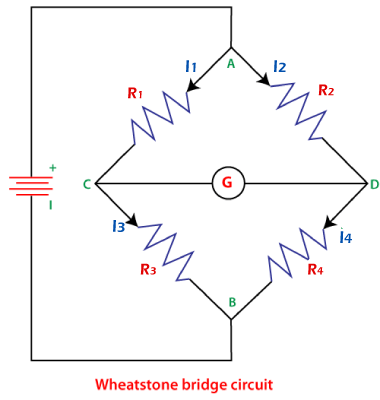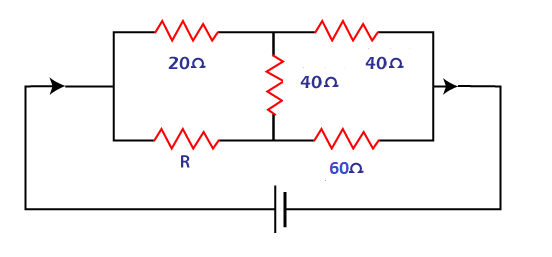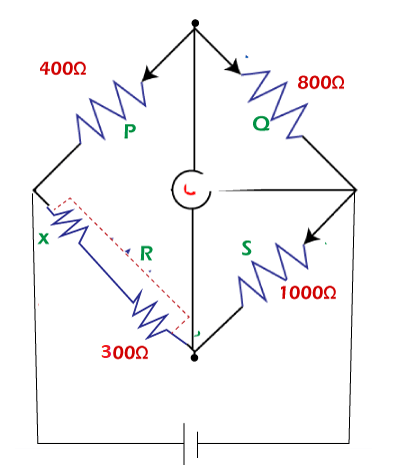Wheatstone bridgeObjectiveThe Wheatstone bridge works on the principle based on the null deflection. When no current flows in the circuit, the ratio of their resistances is equal. It is given by: R1/R2 = R3/R4 R1, R2, R3, and R4 are particularly the four resistances of the Wheatstone bridge. A value of the unknown resistance can be calculated in a quadrilateral if other three resistances are known by applying a voltage between the two opposite corners of the bridge. It is also known as Resistance Bridge. It is quite reliable and well-known for accurate measurements. Connection in a Wheatstone bridgeWheatstone bridge is an arrangement of four resistances R1, R2, R3, and R4 connected in the form of a loop with a single battery, as shown in the below figure. 
We can also name the resistance as P, Q, R and S. The variable name can vary as per the user's choice. It is shown below: 
Both forms of the Wheatstone bridge are the same. A battery is connected between two opposite joints A and B. A galvanometer is connected between the other two points C and D, as shown above. The Galvanometer in the Wheatstone bridge checks the balance of the bridge by sensing the current flowing through the circuit. Let's first discuss Galvanometer. GalvanometerA galvanometer has a center needle that deflects after the flow of electric current through it. It detects if the circuit is balanced or not. The bridge is also balanced where there is no current across the bridge. The readings of the Wheatstone bridge are only taken when it is balanced. Galvanometer only depends on the current for its deflection, not on the voltage. It is because the voltage is resistance is inversely proportional to the voltage. The increase in resistance causes a decrease in voltage. It does not increase voltage sensitivity. The Galvanometer needle deflects to the left if the current flows in one direction and towards right if the current flows in reverse direction. Its main function is to detect the presence of electric current flowing in the circuit. It means that the device show deflection when it detects the electric current flowing in the corresponding circuit. Working of the Wheatstone bridgeThe circuit of the Wheatstone bridge is given above. It clearly shows the four resistances, with a Galvanometer and the battery, which works as the external power supply for the circuit. Remember that this bridge works better while dealing with small resistance values. Let's discuss how the Wheatstone bridge works. As soon as we switch ON the battery, the current starts flowing in the circuit, divided into two branches. The current i from that battery is divided at point A into two parts. Part i1 goes through the resistance R1, and part i2 goes through the resistance R3. As discussed, the current across the Galvanometer is assumed zero for easy calculations and balanced conditions. Now, let's discuss its derivation. DerivationThe given parameters in the Wheatstone bridge are the four resistors with resistances (R1, R2, R3, and R4), current (i), and potential difference across the terminals (VA, VB, VC, and VD), as shown in the circuit. We are not assuming any current across the Galvanometer for this derivation. The bridge is now said to be balanced with the current flowing in the two branches. We can say that current through the resistance R2 is the same as the current through R1. Similarly, the current through resistance R4 is the same as that in R3. Due to the absence of current across the Galvanometer, the potential difference across the four terminals is zero. Thus, VC = VD Applying Ohm's law to R1 and R2, VA - VC = i1R1 VC - VB = i1R2 VA - VC/VC - VB = R1/R2 … (1) Now, applying Ohm's law to R3 and R4, we get VA - VD = i2R3 VD - VB = i2R4 VA - VD / VD - VB = R3/R4 … (2) We know, VC = VD Thus, the left sides of both equations are equal. Equating both equations 1 and 2, we get: R1/R2 = R3/R4 The above equation is known as the balance equation of the Wheatstone bridge. To measure the resistance of a particular resistor, it should be one of the four resistors present in the circuit of the Wheatstone bridge. One of the three resistors should be a variable resistor. Let us suppose that R4 is the resistor whose resistance is to be measured and R3 is the variable resistor. When the bridge is connected with the external power supply, there will a deflection in the galvanometer. The value of the variable resistance is adjusted in a way, such that the galvanometer shows zero reading or no deflection. In this situation, the bridge is balanced with the equation, R4 = R2/R1 x R3 If we know the values of R1, R2, and R3, we can easily find the value of the fourth resistance R4 using the above equation. Advantages of the Wheatstone bridgeA Wheatstone bridge is preferred over other types of bridges because its results are far more precise and accurate. It can also measure minor changes in milliohms. Let's enlist some advantages of the Wheatstone bridge.
Disadvantages of Wheatstone bridgeThe disadvantages of the Wheatstone bridge are as follows:
To overcome the drawback of high resistance measurements, Kelvin's double bridge can be used. It is the modified version of the Wheatstone bridge. It can measure high resistances with high accuracy. Applications of Wheatstone bridgeThe applications of the Wheatstone bridge are as follows:
The Wheatstone bridge can be used for the precise and accurate measurements of low resistance values.
The Wheatstone bridge can be interfaced with other amplifier circuits, which can be further used to measure various parameters like temperature, strain, light, etc. In the case of light detection using the Wheatstone bridge, a light detector sensor is placed in the circuit. It helps to keep track on the changes in the light intensity from dark to light.
The variations in the Wheatstone bridge can also measure inductance, capacitance, and impedance. For example, we can insert a capacitor and a variable capacitor to balance that capacitor, which allows the Wheatstone bridge to measure the capacitance. Numerical ExamplesLet's consider two examples based on the Galvanometer. Example 1: Find the value R in the given circuit if there is no current present in the 40 Ohms resistor. 
Solution: Since, there is no current across the center resistor; we can use the balanced equation. It is given by: R1/R2 = R3/R4 Where, R1 = 20 Ohms R2 = 40 Ohms R4 = 60 Ohms We need to find the value of the unknown resistance R. 20/40 = R/60 R = 30 Ohms We can also name the resistances as P, Q, R, and S. The balanced equation will remain the same. For example, P/Q = R/S There can also be two resistors in series at a single branch. For example, R1 = 20 Ohms, R2 = 30 Ohms, R3 = 40 Ohms and R4 = 50 Ohms +10 Ohms The R4 branch depicts that it contains two resistances in series. The total resistance is series will be added and considered as 50 + 10 = 60 Ohms. Let's consider an example based on this concept. Example 2: Find the value of x in the given Wheatstone bridge. Assume that the bridge is balanced. 
Solution: According to the given question, the resistance values are given as: P = 400 Ohms Q = 800 Ohms R = (300+x) Ohms S = 1000 Ohms Putting these values in the balanced equation, P/Q = R/S We get: 400/800 = 300+x/1000 300 + x = 500 x = 500 - 300 = 200 Ohms Thus, the value of x is 200 Ohms.
Next TopicAngle of rotation
|
 For Videos Join Our Youtube Channel: Join Now
For Videos Join Our Youtube Channel: Join Now
Feedback
- Send your Feedback to [email protected]
Help Others, Please Share










